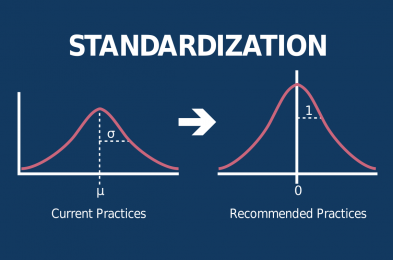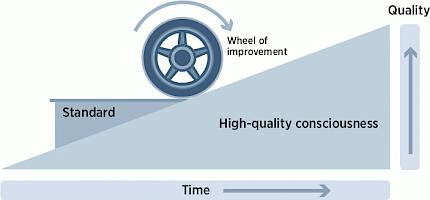Task Standardization: Maximizing Opportunity by Minimizing Variance
Looking back on math class in school, a well-known concept indicates that adding supplementary variables to an equation results in the problem inherently becoming more complex. During on-site lubrication program assessments or public training seminars, I frequently relate back to this and how it aligns with the process and ownership of specific tasks within your lubrication program.
As we begin to review site lubrication processes, let’s take a look at those associated with Lubrication Handling Tasks (H1P). As the number of individuals performing these tasks increases, we begin to see increasing opportunities for a variance to occur. Identifying these needlessly distributed practices and acting on them with controlled administrative measures is imperative to minimizing the overlooked problems I commonly see in plants. As your program advances, the creation of standardized procedures, tasks by application type and application types by the asset will begin to address the unnecessary variance in the program that will pay dividends for years to come.
 Culture is another specific objective that is coincidentally being addressed simultaneously during this standardization. In this context, culture is defined as the common habits, rituals and beliefs of the site. As we begin to organizationally change the steps noted below, reliability leaders are directly affected by how lubrication handling tasks are carried out and play a key role in setting a new expectation for excellence at the site.
Culture is another specific objective that is coincidentally being addressed simultaneously during this standardization. In this context, culture is defined as the common habits, rituals and beliefs of the site. As we begin to organizationally change the steps noted below, reliability leaders are directly affected by how lubrication handling tasks are carried out and play a key role in setting a new expectation for excellence at the site.
A dark blue background with the word “Standardization” written in bold, white letters. Bellow this word are two graphs. The graph on the left features a bell curve and is labelled “Current Practices.” The graph on the right features a taller bell curve and is labelled “Recommended Practices.” An arrow points from the graph on the left to the graph on the right.
Procedure Standardization to Lubrication Tasks
It is vital to understand that when sites choose to work towards improving their lubrication program, they can easily get caught up in physical improvements through capital expenses, such as updates to lubrication rooms, tools and laboratory equipment. While all these have proven benefits if you truly desire the improvements at the site to last for years to come, we must also be extremely aggressive in developing documentation for the program at the outset. I tend to agree that working on specific lubrication procedures is not as exciting as purchasing and installing a fancy new lubrication room, but there is something to be said for buy-in with physical purchases. We as reliability leaders must understand the importance of investing in the long game first.
The initial step is arguably the most important. We must review the procedures for lubricant handling task documentation. At this time, we review certain established practices and the level of detail involved in the delivery of the lubricant to the plant floor. Lack of documentation regarding these practices is extremely common, and when there is documentation, it embodies the bare minimum, such as which lubricant to use. It seldomly identifies how much lubricant or where to specifically apply it. Since this is often the case, it is important that all personnel, including craft, operators, lubrication team members, engineers and management understand the detrimental effect that lack of detail can have on the quality of work. This is imperative for anyone truly interested in nurturing and developing their lubrication program.
 The next step is to recognize and address ongoing variance within the plant’s operations. It’s common for sites to have several highly experienced craft or lubrication team members with a general understanding of the importance of lubrication and adhering to best practices. But what happens when these individuals retire? What happens if they bid out on another job or move to a different company? If this position isn’t prioritized within your plant, it may be given to someone with little experience or given to individuals new to the site in an effort to enhance their familiarity with the department equipment and processes. Either way, it’s highly likely that they will be unaware of previous practices or the importance of the role they are stepping into. Is your site a company that practices Total Productive Maintenance (TPM)? If so, this tends to rely on team members from several different plant organizations (operations, maintenance etc.) to execute miscellaneous lubrication tasks. Consider that even experienced and well-trained individuals may have ancillary activities (home life, other work-related tasks etc.) on their minds while performing lubrication tasks, resulting in substandard performance. All of these are examples where variance can occur due to too many hands being in the pot, individuals not understanding the recipe and failure to stir in unison. We need to recognize this often-present gap and implement a comprehensive strategy to minimize these concerns.
The next step is to recognize and address ongoing variance within the plant’s operations. It’s common for sites to have several highly experienced craft or lubrication team members with a general understanding of the importance of lubrication and adhering to best practices. But what happens when these individuals retire? What happens if they bid out on another job or move to a different company? If this position isn’t prioritized within your plant, it may be given to someone with little experience or given to individuals new to the site in an effort to enhance their familiarity with the department equipment and processes. Either way, it’s highly likely that they will be unaware of previous practices or the importance of the role they are stepping into. Is your site a company that practices Total Productive Maintenance (TPM)? If so, this tends to rely on team members from several different plant organizations (operations, maintenance etc.) to execute miscellaneous lubrication tasks. Consider that even experienced and well-trained individuals may have ancillary activities (home life, other work-related tasks etc.) on their minds while performing lubrication tasks, resulting in substandard performance. All of these are examples where variance can occur due to too many hands being in the pot, individuals not understanding the recipe and failure to stir in unison. We need to recognize this often-present gap and implement a comprehensive strategy to minimize these concerns.
When enhancing your lubrication program, there should be assigned roles and responsibilities along with qualifications for each of these positions. When developing this organizational structure, standardization of procedures should be taking place as well. Each specific lubrication task (and there are several) should be accompanied by a defined procedure.
These specific procedures should include:
- the purpose
- materials necessary to complete the task
- preparation requirements
- task setup
- line by line task execution instruction
- area for recording information
- detail regarding clean up
Additional information relevant to task procedures should include
- task type
- task name
- operation state
- estimated time of completion
- location of lubrication points
- frequency of occurrence
- volume
Addressing this level of procedural documentation within the lubrication program works to ensure that these practices are harmonized and carried out the same way from individual to individual, shift to shift and department to department, every single time they are performed.
Tasks Standardization to Applications
Once procedures are in place for specific lubrication tasks, the next area within Lubricant Handling and Application to focus on is standardization from the tasks to the specific application types. As mentioned earlier, there are several types of lubrication-related procedures that need to be developed into clearly identified tasks. These tasks can then be grouped by application type, with separate groups for categories such as lubrication replenishment, re-greasing and oil top-ups, or equipment inspections, filtration and sampling.
Most underdeveloped lubrication programs group these specific application types into assorted overall lubrication PMs or even part of other PMs not related to lubrication and instead associated with various other plant activities. It is during this process that sites lose sight of the importance of details, resulting in diminished value of the task at hand, compounding the variance in task performance. Once all standardized procedural tasks have been properly developed, they must be grouped in specific application-based lubrication PMs like the ones noted above. This should add precision to tasks at hand and maintain a level of definition within each group of tasks carried out.
A stylized graph with several shades of grey. The x-axis of the graph is labelled “Time” and has an arrow pointing to the right. The y-axis is labelled “Quality,” and has an arrow pointing upward. Within the graph is a right triangle, showing that, as time moves forward, quality increases. A circle sits on top of the triangle and is labelled “Wheel of Improvement.” An arrow above the circle implies that it is moving up the incline of the triangle.
Application Standardization to Assets
Finally, after developing standardized documentation processes for procedural tasks and application types, we begin to look at normalizing these application types in the form of PMs on equipment types in the field. Once again, it is all about minimizing variance in order to achieve lubrication excellence.
For equipment already present on the plant floor, a guideline should be developed for application types based on categories of components such as pumps, motors and gearboxes. While criticality and size can vary for each component type, the levels of execution can be put in place for small, medium and large assets alike. This information is often organized during the development of a corporate lubrication standards manual but can also be useful during Failure Modes Effects Analysis (FMEA) and Management of Change (MOC) documentation.
Similarly, there needs to be an established guideline for incoming future equipment as well. While the steps mentioned above can be utilized, an additional form of control with regards to employing application task types to inbound equipment should be implemented. One way this can be managed is with TPM measures in the form of Early Equipment Maintenance (EMM). Applying these documents and processes can aid in application type deployment of onsite assets and drive standardization of task execution.
Wrapping Things Up
 In summary, when reviewing your site’s lubrication activities, there may be numerous opportunities for variance during the Lubricant Application Tasks (H1P) processes. Identifying an improvement, formalizing these processes and acting on them with administrative measures will directly lead to minimizing overlooked downfalls in your program. Finally, do not forget to consider the fact that these techniques directly influence both standardization and process improvement, as well as deliver enhanced long-term site cultural development.
In summary, when reviewing your site’s lubrication activities, there may be numerous opportunities for variance during the Lubricant Application Tasks (H1P) processes. Identifying an improvement, formalizing these processes and acting on them with administrative measures will directly lead to minimizing overlooked downfalls in your program. Finally, do not forget to consider the fact that these techniques directly influence both standardization and process improvement, as well as deliver enhanced long-term site cultural development.
References
- https://www.machinerylubrication.com/Read/257/lube-procedures
- https://www.machinerylubrication.com/Read/2302/lubrication-pm-procedures
- https://www.machinerylubrication.com/Read/31435/lubrication-task-procedures
- https://www.process.st/process-standardization/
